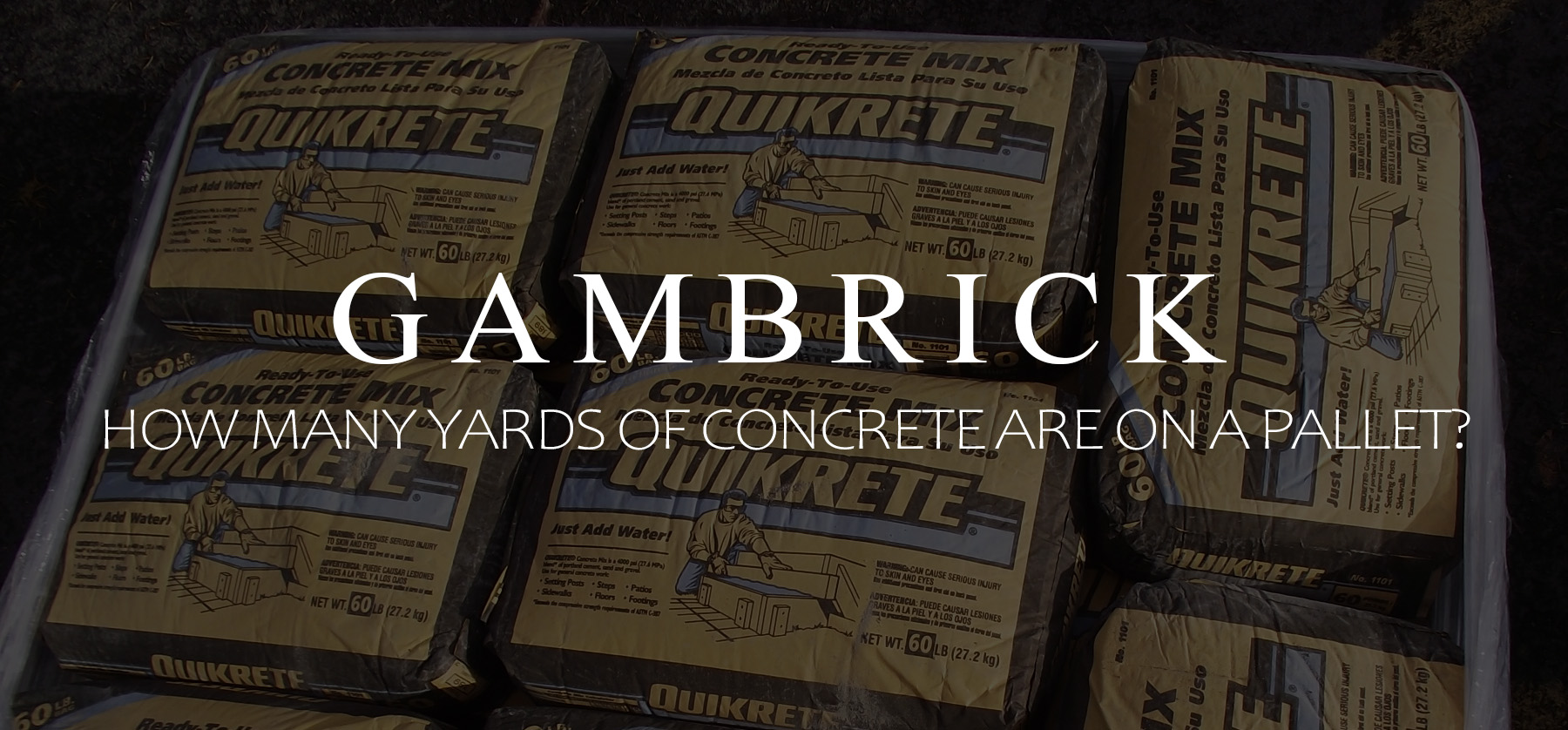How Many Yards Of Concrete Are On A Pallet?
How many yards of concrete are on a pallet depends on the size bag you buy. Concrete bags come in different sizes ranging from 40 lbs. to 80lbs. The amount of bags you get on a full pallet also depends on the bag size. No single pallet of concrete holds a full yard of concrete. A pallet of 80 lb. bags holds 42 bags equaling .9333 yards of concrete. So just under a full yard. To buy a full yard of concrete you’d need 45 bags or a full pallet plus 3 bags.
Below I’ve put together a chart showing bag weight, bags per pallet, total weight, yards of concrete per bag, bags needed per yard, yards of concrete per full pallet and price per bag. With this chart you can figure out exactly how many bags to buy per job.
| Bag Weight 40 LB. 50 LB. 60 LB. 80 LB. |
Number Of Bags Per Pallet 80 Bags 64 Bags 56 Bags 42 Bags |
Total Weight 3,200 lbs. 3,200 lbs. 3,360 lbs. 3,200 lbs. |
Yards Per Bag 0.0111 Yards 0.013875 Yards 0.01665 Yards 0.0222 Yards |
Bags Per Yard 90 Bags 72 Bags 60 Bags 45 Bags |
Yards Per Pallet 0.888 0.888 0.9324 0.9333 |
Pallet & Individual Bag Price $2.75 per bag/ $220.00 per pallet $3.28 per bag/ $209.92 per pallet $3.99 per bag/$223.44 per pallet $4.80 per bag/$201.60 per pallet |
Exact prices can vary based on the brand and where you buy it. Special mixes like self leveling concrete also effect the price.
When bagged concrete like Quikrete is delivered in bulk it typically comes on a pallet. I’ve been a mason for over 25 years and can tell you firsthand that this makes it much easier to transport around a job if you have a fork lift or bobcat.
Yards Of Concrete Per Pallet
A full pallet of concrete makes just under one cubic yard of concrete. No matter what size bag you buy, the total yards of concrete ranges from .888 to .9333.
- One 80lb. bag yields .0222 yards of concrete. A pallet contains 42 bags or .9333 total yards of concrete. You need 45 bags of 80lb. concrete to equal a full yard.
- One 60lb. bag yields .01665 yards of concrete. A pallet contains 56 bags or .9324 total yards of concrete. You need 56 bags of 60lb. concrete to equal a full yard.
- One 50lb. bag yields .013875 yards of concrete. A pallet contains 64 bags or .888 total yards of concrete. You need 72 bags of 50lb. concrete to equal a full yard.
- One 40lb. bag yields .0111 yards of concrete. A pallet contains 80 bags or .888 total yards of concrete. You need 90 bags of 40lb. concrete to equal a full yard.
On average, pallets filled with smaller bags of concrete only yield about a cubic foot less of total concrete.
Whenever I order concrete bags for a project, I always order the bag size that makes the most sense for the job. Not the bag that yields the most concrete per pallet because they’re all about the same. None of the bag sizes equal a full yard of concrete per pallet so I always need to order a few extra bags no matter the size.
I recommend using the bag size you can comfortably handle. Buying concrete by the bag means you’ll be transporting and mixing the concrete by yourself.
Buying A Yard Of Concrete
Concrete typically comes bagged in weights of 40, 50, 60 and 80 pounds. Standard concrete is offered in every weight but some specialty mixes are only offered in lighter bags.
When your at a store like Home Depot, you may notice the concrete pallets are sometimes wrapped in plastic with a number on them written in marker. This is the number of bags on the pallet. Sometimes stores will order an odd number or add leftover bags from another pallet onto a fresh one. This can create odd numbers.
If you need a specific amount of concrete bags on a pallet, the store can “add to”, or “take away from” the amount of bags on a standard pallet. They’ll usually do this when you need a few more bags than a standard pallet holds rather than deliver two pallets. This is the case when you need to order a full yard. They’ll usually give you a full pallet plus the number of bags to need to make the yard.
Once you know how many yards of concrete you need, divide that number by the yards per bag number in the table above. That will tell you exactly how many bags of concrete you need. Your supplier will create a pallet or pallets depending on the amount of bags you need.
Ordering concrete yards by the pallet may seem difficult at first but once you get the hand of it it’s actually pretty simple to figure out.
Ordering Pallets of Concrete
Concrete projects are measured in cubic feet or yards because they have depth. This is a measurement of volume and not simple square footage. The basic calculation is length x width x depth.
I recommend using a concrete calculator to figure out exactly how many yards of concrete are in your project. They’re free and easy to use.
Once you know how many yards of concrete you need, figuring out how many bags to order is easy.
To calculate the yardage you’ll get out of a pallet of concrete, follow these steps:
- Yards Per Bag: The number of cubic feet per bag is listed on the chart above. It’s .o222 for an 80 lb. bag, 0.01665 per 60 lb. bag, 0.013875 for a 50 lb. bag and 0.0111 for a 40 lb. bag.
- Divide: Next, divide the amount of yards you need by the yards per bag. Make sure you use the correct number for the bag size you’re using. For example, if you need 3 yards of concrete and are using 80 lb. bags, divide 3 by 0.0222. The answer is 135.135 bags of concrete. So you’d order 136 and have just a little left over.
When it comes time to order the concrete, suppliers will ship by full pallet unless you need a few extra bags. In the example above, you need 136 bags of concrete but only 42 fit on a pallet. So you’d order 2 pallets with 42 each and one with 52.
Number Of Concrete Bags On A Full Pallet
The number of concrete bags that come on a full pallet depend on how heavy the bags are. The typical sizes for concrete bags are 40, 50, 60, and 80 lbs (18.14, 22.58, 27.22, and 36.29 kg).
How many bags come on a full pallet breaks down as follows:
- 80 – 40 pound bags per pallet
- 64 – 50 pound bags per pallet
- 56 – 60 pound bags per pallet
- 42 – 80 pound bags per pallet
The number of bags on a pallet decreases as the bags get heavier, but the total weight remains about the same. Regardless of bag size, the total weight of a full pallet will generally be around 3,200 to 3,400 lbs (1,451.5 to 1,542.21 kg) of concrete plus the pallet. A wood pallet weighs around 40 pounds. So if you’re picking up the pallet in a pickup truck, you’ll need one that can carry or tow around 1 3/4 tons.
Does Bag Size Matter When Buying Concrete?
Bag size doesn’t matter in terms of the concrete. The same concrete that’s in a 40 lb. bag is also in an 80 lb. bag. The only difference is that there’s twice as much in the heavier bag. But you do get slightly more concrete per pallet ordering 80 lb. bags vs 40 lb. bags. So if space on your job is limited, it’s better to order the heavier bags.
If you’re thinking about the work, it’s easier to carry around and mix lighter bags. This is why a lot of masons I know order 40 lb. – 60lb. bags instead of 80lb. If you’ve got 400 bags to carry and mix it can be a lot easier on your body. But it’s also slower. It takes time to cut open each bag and load it into the mixer. The more bags you have the more time you spend cutting, transporting, loading and mixing.
Personally, I always work with the 60lb. bags. They’re easier to lug around and don’t take that much more time to cut open and mix. I’d rather spare my back than save an hour or so per project. I recommend using the bag size that you can comfortably carry without causing an injury or straining yourself.
A typical pallet of concrete holds around 3,200 to 3,400 lbs (1,451.5 to 1,542.21 kg) of concrete. Whether it’s 80 – 40 lb. (18.14 kg) bags or 42 – 80lb. (36.29 kg) bags, the total weight is about the same. And the total yards of concrete per pallet are about the same too.
How To Determine How Many Bags Of Concrete You Need
Determining how much concrete you need for a project is very important. Most project require all the concrete to be poured in one single pour, which means running short can be a disaster. For this reason I always recommend buying a few extra bags just in case.
Remember that concrete is a volume calculation, not simple square footage. It’s basically figuring out square footage and then adding depth. To calculate how much concrete you’ll need, multiply the length x width x depth of the space where you’ll be pouring concrete.
If you’re measuring in feet, this will tell you the number of cubic feet you need. For example, if you’re pouring a 3′ x 3′ x 7′ pier, you’d need 63 sq. ft. of concrete.
Once you’ve figured out the cubic feet of concrete you’ll need, you have to convert that number into cubic yards.
To figure out cubic yards, simply divide the cubic feet you need by the number of cubic feet in a cubic yard (27). This gives you the number in cubic yards (63 ÷ 27 = 2.333 cubic yards).
Then, divide the number of cubic yards you need by the amount of cubic yards per bag. 80lb. bags have .0222 yards of concrete per bag, so divide 2.333 by .0222 and get 105. So that 3′ x 3′ x 7′ concrete pier needs 105 80lb. bags of concrete to pour. I recommend ordering at least 110 just in case.
Calculating How Many Pallets Of Concrete You Need
Once you know the total cubic feet of concrete you need, convert that number to cubic yards. The calculation is simple and listed above. But to recap, you divide the square feet of concrete by 27. This converts the number to cubic yards.
Once you know how many cubic yards of concrete you need, choose a bag size. Each bag has a different amount of concrete inside based on the weight of a bag. The table listed above will tell you how much concrete in cubic yards is in each bag size.
Divide the total cubic yards you need by the amount of concrete in each bag. Here’s an example. Lets say you need 2 yards of concrete and want to use 60lb. bags. Each 60lb. bag contains 0.01665 yards of concrete. Divide 2 yards by 0.01665 yards per bag and you get 120.12 60lb. bags of concrete.
Only 56 bags of 60lb. concrete come on a pallet, so you need to order more than 2 full pallets.
How Many Yards Of Specialty Concrete Mixes Are On A Pallet
Quikrete and Sakrete are both popular brands of concrete mix that you can buy at Home Depot or Lowes. Each brand offers different concrete mixes with special properties in addition to the standard mix.
Concrete bags are placed on a pallet by weight, it has nothing to do with the mix. For example, 42 bags of 80 lbs standard concrete are on a full pallet. 42 bags of 80lbs. Quikrete 5000 concrete mix also come on a full pallet. This is because the weight per bag is the same.
The amount of yards that come on a pallet are exactly the same too. .9333 yards of 80lb. concrete comes on a pallet. It doesn’t matter what type of mix is in the bag. All that matters is the weight.
How many yards of concrete you need for your project is also the same regardless of the mix you use.
Specialty Mixes By Bag Weight
- Ready to Use Concrete Mix. 40, 60, and 80 lbs bags. $4.99 per bag.
- Fast Setting Concrete Mix. 50 lbs bags. $5.25 per bag.
- Quikrete 5000 Concrete Mix. 60 or 80 lbs bags. $7.99 per bag.
- Crack Resistant Concrete Mix. 60 and 80 lbs bags. 6.5o per bag.
- Countertop Mix. 80 lbs bags. $19.99 each.
- Mortar Mix. 10, 40, 60, or 80 lbs bags. $7.99 per bag.
- Mason Mix. 60 or 80 lbs bags. $6.50 per bag.
It’s important to know the type of concrete and the amount of bags you’ll need for a project.
Think about how you’ll be moving the bags around. This can help you decide on which bag size is best. If I can place the bags right by the job, I get 80 lbs bags and mix 2-3 at a time in my mixer. A typical side walk project may take 2-3 pallets of concrete to complete. However, if I have to lug the bags really far from the delivery spot, I use lighter bags.
For smaller projects like concrete countertops, I prefer 50lbs bags.
What Does A Pallet Of Concrete Cost?
This table will give you a general idea of what a pallet of concrete costs at the time I wrote this post which is March, 2022. Expect prices to change over time. It also matters where and when you buy the concrete. Shop around because someone will usually have bags on sale.
Bulk ordering also matters. Most supplier will give you a discount when you order full pallets rather than by the bag.
Also expect to pay sales tax. Here in New Jersey our sales tax is 7% but there are designated areas where sales tax is only 3 1/2%. This can save a lot when your order thousands of dollars worth of material.
| Type Of Concrete Concrete MIx Concrete Mix Quikrete 5000 Crack Resistant Mix Fast Setting Mix |
Size 60 lb. 80 lb. 50 lb. 60 lb. 50 lb. |
Bags On The Pallet 56 42 64 56 64 |
Total Cost $223.44 $201.60 $216.32 $394.00 $335.52 |
How Many 80lb. Bags Of Concrete Are In A Yard?
45 bags of 80lb. concrete make a yard. One 80lb. bag of Concrete Mix will yield approximately .60 cu ft. or 0.0222 cubic yards of concrete. Divide 1 cubic yard by .0222 and you get 45. So it takes about 45 bags to equal one cubic yard of concrete.
Does One Pallet Of Concrete Equal One Cubic Yard?
A full pallet of concrete does not equal a full cubic yard of concrete. No matter what bag size you choose, you’ll always have less than a full yard.This means you’ll have to buy a full pallet plus some extra bags. The amount of extra bags you need depends on the weight of the bags you choose.
I’ve put together a chart below to help you with your order.
| Bag Weight 40 LB. 50 LB. 60 LB. 80 LB. |
Bags Per Pallet 80 Bags 64 Bags 56 Bags 42 Bags |
Total Weight 3,200 lbs. 3,200 lbs. 3,360 lbs. 3,200 lbs. |
Yards Per Bag 0.0111 Yards 0.013875 Yards 0.01665 Yards 0.0222 Yards |
Bags Per Yard 90 Bags 72 Bags 60 Bags 45 Bags |
Yards Per Pallet 0.888 or 88.8% 0.888 or 88.8% 0.9324 or 93.24% 0.9333 or 93.33% |
Bags Needed For 1 Yard 90 Bags 72 Bags 60 Bags 45 Bags |
Summary: How Many Yards Of Concrete Are On A Pallet?
How many yards of concrete are on a pallet depends on the size bag you buy. Concrete bags come in different sizes ranging from 40 lbs. to 80lbs. The amount of bags you get on a full pallet also depends on the bag size. No single pallet of concrete holds a full yard. A pallet of 80 lb. bags holds 42 bags equaling .9333 yards of concrete. So just under a full yard. To buy a full yard of concrete you’d need 45 bags or a full pallet plus 3 bags.
Below is a breakdown listing how many yards of concrete are on a pallet based on bag size.
A full pallet of concrete makes just under one cubic yard of concrete. No matter what size bag you buy, the total yards of concrete ranges from .888 to .9333.
- One 80lb. bag yields .0222 yards of concrete. A pallet contains 42 bags or .9333 total yards of concrete. You need 45 bags of 80lb. concrete to equal a full yard.
- One 60lb. bag yields .01665 yards of concrete. A pallet contains 56 bags or .9324 total yards of concrete. You need 56 bags of 60lb. concrete to equal a full yard.
- One 50lb. bag yields .013875 yards of concrete. A pallet contains 64 bags or .888 total yards of concrete. You need 72 bags of 50lb. concrete to equal a full yard.
- One 40lb. bag yields .0111 yards of concrete. A pallet contains 80 bags or .888 total yards of concrete. You need 90 bags of 40lb. concrete to equal a full yard.
On average, pallets filled with smaller bags of concrete only yield about a cubic foot less of total concrete.
If you have any questions or comments about concrete, email or leave a comment below.

John Mazzuca | About | More Posts |
Custom Home Builder
John Mazzuca is a custom home designer and builder at Gambrick with over 25 years experience in the construction industry. John has designed, built and/or remodeled hundreds of homes, small buildings, and commercial projects. He writes about business, real estate, home building, and household electronics. His work has been featured in Fox Business, Better Homes & Garden, House Beautiful, and more.





















